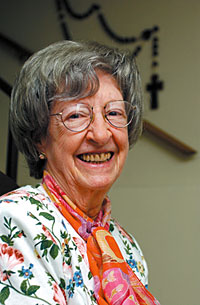Sallie Ann Watkins
DOI: 10.1063/PT.3.1760
Educator, mentor, and influential conscience for many communities, Sallie Ann Watkins was our beloved teacher, colleague, and friend. Born on 27 June 1922 in Jacksonville, Florida, she passed quietly away on 21 December 2011 in Pueblo, Colorado. Her love of physics helped us and the subject find one another. To her, physics was a means to interpersonal relationships. She was a steadfast source of wise, uplifting encouragement.
From childhood, Sallie wanted to spend her life in service to others, so she joined the Sisters of Notre Dame and became Sister Mary Howard. She graduated with honors in 1945 from Notre Dame College (NDC)—at the time an all-women’s school—in Cleveland, Ohio, with a degree in chemistry, and then taught high school chemistry at Notre Dame Academy. In 1950 she joined the NDC faculty. Drafted to teach physics, she attended the Catholic University of America in Washington, DC, from 1954 to 1958 and earned master’s and PhD degrees in the subject. Her dissertation was entitled “Ultrasonic absorption and velocity in liquid monochloroethane.” She continued her work at NDC from 1957 to 1966, during which she served as physics department chairperson and as dean of students.
Sallie’s actions expressed her passion for social justice, education, women’s equality, and environmental responsibility. The 1962 reforms of Vatican II informed her activism. She and 10 other sisters exchanged their habits for street clothes, reclaimed their original names, and in 1966 migrated to Pueblo to form the Community of Christian Service. Sallie joined the physics faculty at Southern Colorado State College (later the University of Southern Colorado [USC] and now Colorado State University-Pueblo). Her roles included being chair of the physics department, dean of the College of Science and Mathematics, and assistant vice president for research. Her activism included protesting the Vietnam War and being the first Colorado member of the National Organization for Women.
Sallie was cheerfully optimistic, but she was also tough and realistic. From tracking education legislation to developing curricula, she did her homework thoroughly and made her point firmly with a disarming smile. One alumna wrote, “Sallie exemplifies inspiration and teamwork, and thrives in an environment of doubt.”
Sallie was a principal investigator on nine major grants, a sought-after colloquium speaker and consultant, and an influential member of nine professional societies. She wrote dozens of papers on ultrasonics, nuclear reactors, x-ray fluorescence, and innovative education, and many of her physics history essays focused on the work of Lise Meitner.
After retiring from USC as professor emerita in 1988, Sallie launched another career, overseeing elementary school programs that emphasize hands-on science, community involvement, research-based curricula, and proactive responses to the underrepresentation of girls and minorities in science. Those NSF-funded programs featured teachers working in cooperative learning teams. The first program started in 1988 with the University City Schools near Saint Louis, Missouri, followed by a 1993 collaboration between USC and Pueblo School District 60. Noting a steep rise in test scores, John Rigden, then with the American Institute of Physics and a coinvestigator with Sallie in St. Louis, said, “Sallie had a way of reducing tensions. Although she had an iron fist under her velvet gloves, the teachers never felt intimidated by her.”
Sallie’s influence radiated far beyond the physics community. In Pueblo, she lived in low-income housing, worked tirelessly on local social issues such as feeding the homeless in the city’s soup kitchen, and volunteered for numerous civic and charitable organizations. She was a member of the Governor’s Science and Technology Advisory Council; the Governor’s Mathematics, Science, and Technology Commission; and the steering committee for Pueblo’s District 60 Teacher Award.
Upon retirement, Sallie designed and occupied an environmentally friendly house, with passive convective cooling and with photovoltaic cells in a system that was one of the first household installations returning energy to the grid. Whatever Sallie advocated publicly, she practiced privately.
For her extensive service to physics education, Sallie was recognized with many awards, among them the 2001 American Association of Physics Teachers’ Robert A. Millikan Medal. But no higher standard exists for gauging a teacher’s impact than student responses. In 2002 some USC alumni initiated a Sallie Watkins Scholarship, noting that “Watkins’ teaching philosophy was that every teacher has a sacred trust to support, encourage, and bring to blossom the talents and capabilities of every student.”
Sallie counseled current and former students through professional decisions and personal crises. One student recalls, “Sallie served as an example of what a modern woman could do, both as a moral force in the world and as a contributing member of society. When I left my small all-female college to attend graduate school, I found that she had prepared me to face those who thought that young women did not belong in grad school.” Another said, “Sallie could see the person beneath the behavior. Ever since then, I remember that priority whenever I confront a student facing internal struggles.”
It seems fitting to close this memorial to Sallie with a passage from the Book of Proverbs: “She is a woman of strength and dignity. . . . When she speaks, her words are wise, and kindness is the rule for everything she says.”

Sallie Ann Watkins
PUEBLO CHIEFTAIN

More about the Authors
Mary Kay Hemenway. University of Texas at Austin.
Dwight E. Neuenschwander. Southern Nazarene University, Bethany, Oklahoma.




